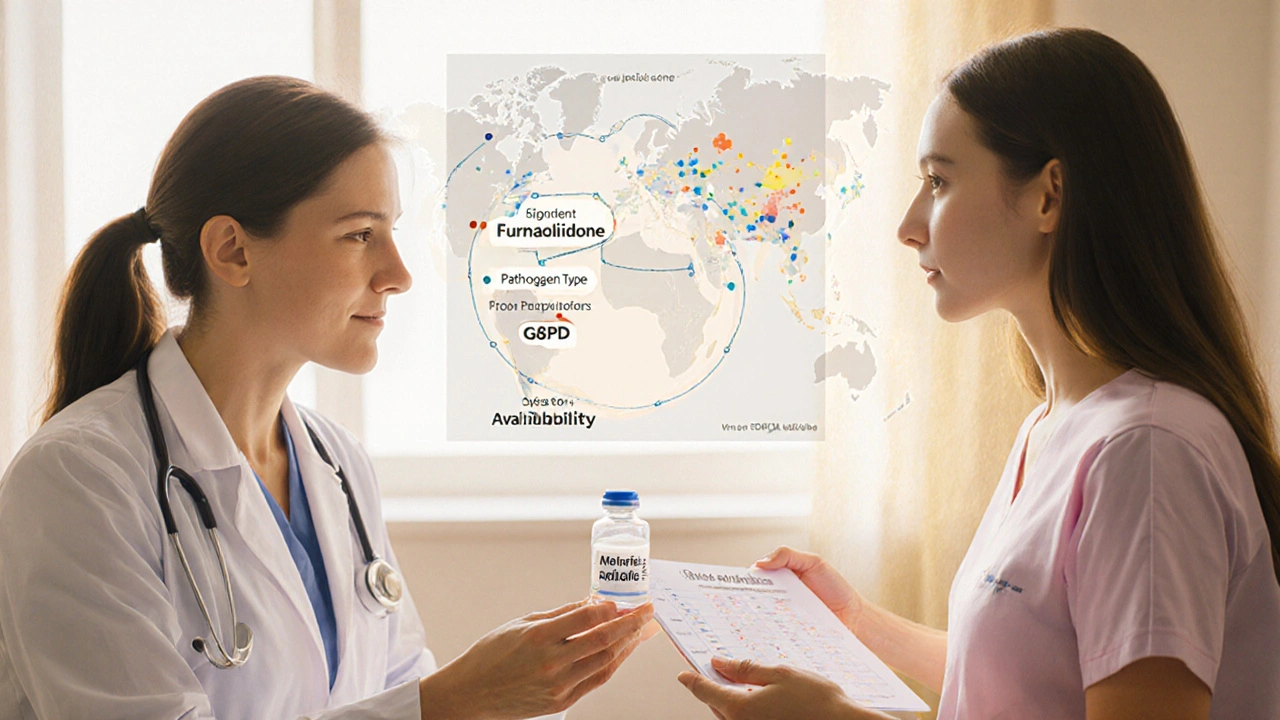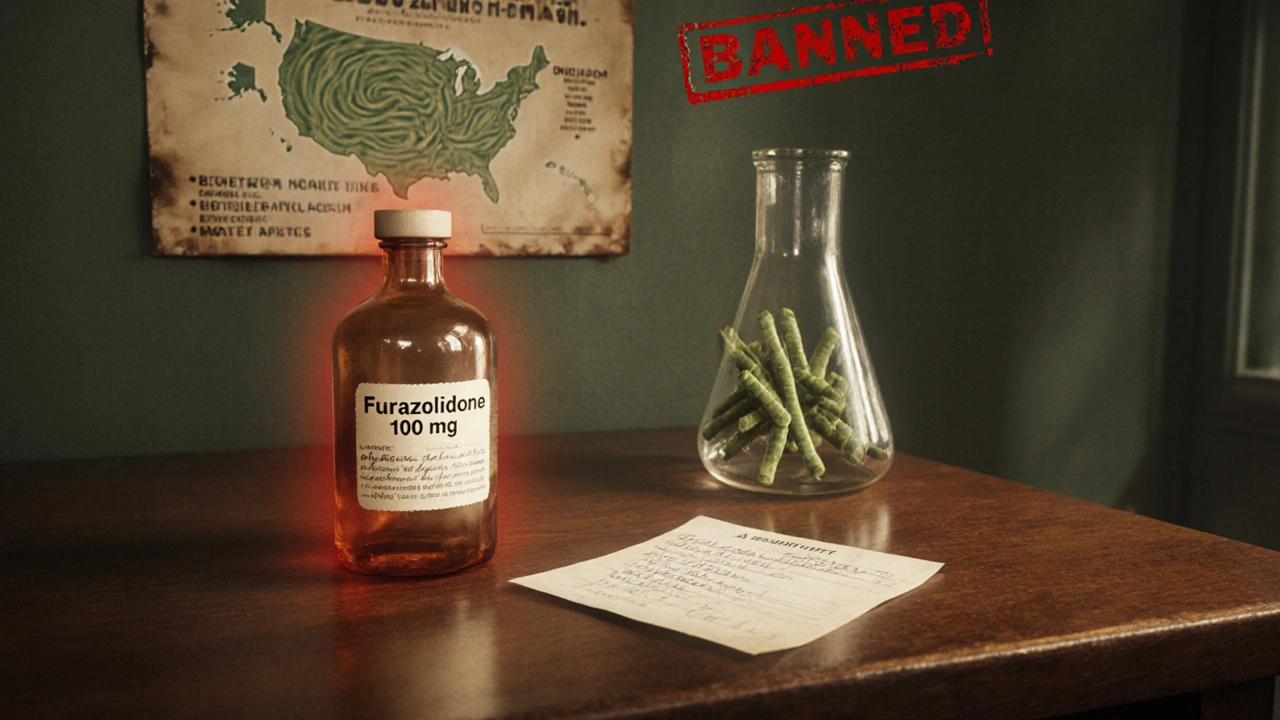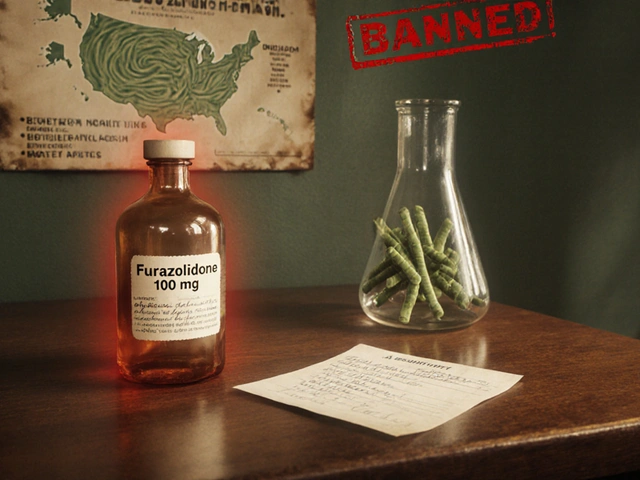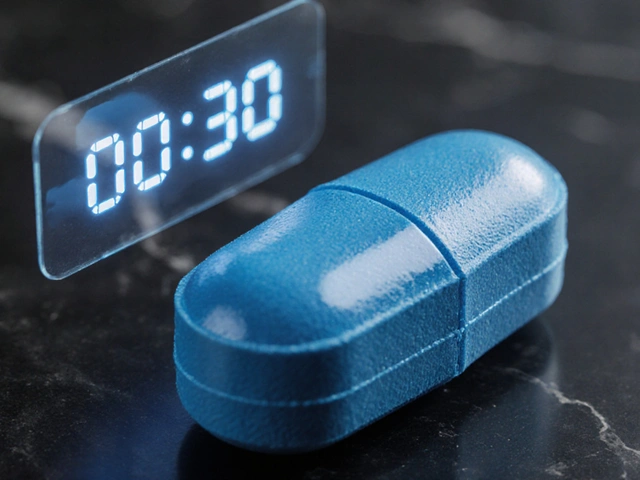When a doctor prescribes Furazolidone is a nitrofuran antibiotic traditionally used for bacterial diarrhoea, giardiasis and some respiratory infections. Over the past decade many countries have restricted or banned it because of safety concerns, prompting patients and clinicians to look for Furazolidone alternatives. This guide compares the drug with the most common substitutes, walks through when each one makes sense, and highlights red‑flags you should watch for.
Key Takeaways
- Furazolidone is effective against a narrow set of anaerobic bacteria but carries a high risk of severe side effects and drug interactions.
- Metronidazole and Tinidazole are the go‑to alternatives for most gastrointestinal infections, offering similar efficacy with better safety profiles.
- For broader‑spectrum needs, fluoroquinolones like Ciprofloxacin or macrolides such as Azithromycin are often preferred.
- Regulatory status varies: Furazolidone is banned in the US, EU and Canada, while most alternatives remain approved worldwide.
- Always match the drug’s spectrum to the pathogen and consider patient factors (age, pregnancy, liver function) before switching.
What is Furazolidone?
Furazolidone is a nitrofuran antimicrobial that works by disrupting bacterial DNA synthesis. It was first introduced in the 1950s and became popular for treating dysentery, cholera and giardiasis, especially in low‑resource settings.
Typical adult dose: 100mg three times daily for 5‑7days, taken with food to reduce gastrointestinal irritation.
Common side effects include nausea, headache, metallic taste, and, more seriously, hemolytic anemia in people with G6PD deficiency, peripheral neuropathy, and possible carcinogenic risk, which led to bans in many high‑income countries.
Because of these concerns, clinicians now consider it a second‑line option, reserving it for cases where first‑line agents fail or are unavailable.
Top Alternatives and When to Use Them
| Drug | Class | Typical Indication | Adult Dose | Common Side Effects | Regulatory Status |
|---|---|---|---|---|---|
| Furazolidone | Nitrofuran | Giardiasis, bacterial dysentery | 100mg PO TID ×5‑7d | Nausea, hemolysis (G6PD), neuropathy | Banned in US/EU/Canada; limited use elsewhere |
| Metronidazole | Nitroimidazole | Giardiasis, bacterial vaginosis, C.difficile | 250‑500mg PO BID ×5‑7d | Metallic taste, nausea, rare neurotoxicity | Approved worldwide |
| Tinidazole | Nitroimidazole | Giardiasis, trichomoniasis | 2g PO single dose | Headache, dizziness, mild GI upset | Approved in many countries, not US |
| Ciprofloxacin | Fluoroquinolone | UTI, travelers' diarrhea, respiratory infections | 500mg PO BID ×3‑7d | Tendonitis, QT prolongation, GI upset | Approved worldwide, warnings on tendon risk |
| Azithromycin | Macrolide | Respiratory infections, STI, atypical pneumonia | 500mg PO daily ×3d | Diarrhea, QT prolongation, hepatic enzymes | Approved worldwide |
| Rifaximin | Rifamycin derivative | Travelers' diarrhea, hepatic encephalopathy | 550mg PO TID ×3d | GI discomfort, nausea | Approved in US/EU |
| Trimethoprim‑sulfamethoxazole | Combination sulfonamide | UTI, certain GI infections | 800/160mg PO BID ×5‑7d | Rash, hyperkalemia, rare Stevens‑Johnson | Approved worldwide |
| Doxycycline | Tetracycline | Travelers' diarrhea, Lyme disease | 100mg PO BID ×7‑14d | Photosensitivity, esophagitis, GI upset | Approved worldwide |
How to Choose the Right Alternative
Picking a substitute isn’t just about swapping pills; you need to match three key factors:
- Pathogen profile: Is the infection caused by an anaerobe, a gram‑negative rod, or an atypical organism? Nitroimidazoles (Metronidazole, Tinidazole) excel against anaerobes, while fluoroquinolones cover many gram‑negatives.
- Patient safety: Age, pregnancy status, liver/kidney function, and G6PD deficiency dramatically affect risk. For example, Metronidazole is pregnancy‑category B, whereas Furazolidone is contraindicated.
- Regulatory & access considerations: In the US, you can’t legally prescribe Furazolidone, but you can get Metronidazole with a standard prescription. Some alternatives like Tinidazole may require special approval.
When these three align, you’ll have a clear front‑runner.

Safety Profile Deep Dive
Below is a quick safety snapshot for the most frequently compared drugs.
- Furazolidone: Risk of hemolytic anemia in G6PD‑deficient patients, possible carcinogenicity, and peripheral neuropathy. Monitoring required for long courses.
- Metronidazole: Generally well tolerated; avoid alcohol (disulfiram‑like reaction). Watch for rare seizures in high‑dose IV use.
- Tinidazole: Similar to Metronidazole but with a longer half‑life, allowing single‑dose regimens. Less well studied in pregnancy.
- Ciprofloxacin: Tendon rupture risk rises after age 60 or in steroid users. Also can cause QT prolongation; electrolyte monitoring advised.
- Azithromycin: Cardiac risk (QT prolongation) especially with other QT‑prolonging drugs.
Understanding these nuances helps you explain why a clinician might swap Furazolidone for a safer partner.
Cost and Availability Considerations
In many developing regions Furazolidone remains cheap (≈USD0.10 per 100mg tablet). However, its ban in high‑income markets drives up the cost of alternatives:
- Metronidazole-generic versions cost about USD0.20 per 500mg tablet.
- Tinidazole-often pricier, around USD1.00 per 500mg tablet, and may need import.
- Ciprofloxacin-USD0.30 per 500mg tablet, widely available.
If you’re traveling or living in a region with limited pharmacy options, the cheapest drug that still meets safety standards is usually preferred.
Practical Switching Guide
To move from Furazolidone to an alternative without compromising treatment, follow these steps:
- Confirm diagnosis: Ensure the pathogen is susceptible to the new drug (e.g., Metronidazole works for Giardia).
- Check contraindications: Verify G6PD status, pregnancy, renal function.
- Select dose: Use the table above for adult dosing; adjust for weight or renal impairment.
- Educate the patient: Explain side‑effect profile, especially alcohol avoidance with Metronidazole.
- Monitor response: Re‑evaluate symptoms after 48‑72hours; if no improvement, consider culture‑guided therapy.
Switching is usually smooth; most patients tolerate Metronidazole or Tinidazole better than Furazolidone.
Frequently Asked Questions
Why is Furazolidone banned in many countries?
Regulatory agencies flagged the drug for possible carcinogenicity, severe hemolytic anemia in G6PD‑deficient patients, and neurotoxicity. The risk‑benefit ratio didn’t favor continued use, especially when safer alternatives exist.
Can I take Metronidazole if I’m pregnant?
Metronidazole is classified as pregnancy category B in the US, meaning animal studies haven’t shown a risk and there are limited human data. Doctors often prescribe it for trichomoniasis or bacterial vaginosis during pregnancy when benefits outweigh potential risks.
Is a single dose of Tinidazole as effective as a 5‑day Metronidazole course?
Clinical trials show a 2g single dose of Tinidazole achieves cure rates similar to a 5‑day Metronidazole regimen for Giardia and Trichomonas infections, with better patient adherence due to convenience.
What should I do if I develop a rash while on Furazolidone?
Stop the medication immediately and contact a healthcare professional. A rash could signal an allergic reaction or early signs of hemolysis, especially in G6PD‑deficient individuals.
Are there any drug interactions with Ciprofloxacin I should watch?
Yes. Avoid taking Ciprofloxacin with antacids or calcium‑rich supplements within two hours, as they reduce absorption. Also, watch for increased risk of tendon injury when combined with corticosteroids.

Bottom Line
If you’re currently on Furazolidone, you’re likely dealing with a region where it’s still accessible. The safest move is to discuss with your prescriber a switch to Metronidazole or Tinidazole for most GI infections, or consider a broader‑spectrum agent like Ciprofloxacin if the pathogen is uncertain. By matching the drug’s spectrum, safety profile, and local availability, you’ll get effective treatment without the extra baggage Furazolidone carries.








Comments
Thank you for compiling such an extensive overview of Furazolidone and its alternatives. Your systematic comparison of efficacy, safety, and regulatory status is exceptionally clear. It is evident that you have consulted multiple sources to ensure accuracy. The practical switching guide, in particular, offers clinicians a valuable checklist. I appreciate the balanced tone that neither dismisses Furazolidone outright nor overlooks its risks. This kind of nuanced discussion is precisely what the medical community needs.
Great summary! I love how you broke down the side‑effects in simple bullet points. Makes it super easy to grab the key info at a glance.
Yo, this guide really hits the spot. I was kinda lost on when to actually ditch Furazolidone for something safer. The part about G6PD deficiency hit home – I’ve seen a couple of cases where folks ended up anemic. Also, the cost breakdown is clutch for low‑resource settings, where budget is always tight. Thanks for keeping it real and not just spittin’ textbook jargon. Keep doing the good work!
What a masterpiece of medical writing!!!; Your table is crystal‑clear; the dosing regimens are laid out with surgical precision, and every drug class is highlighted with impeccable detail; I must commend the author for the thoroughness!!!; The discussion on regulatory status reads like a legal brief-exact, authoritative, and utterly persuasive; Moreover, the safety profile deep dive is nothing short of an academic tour de force; each bullet point is not merely listed but contextualized with mechanisms of toxicity; The author even managed to embed nuanced guidance for special populations-pregnant patients, the elderly, and those with hepatic impairment-without the prose becoming unwieldy; There is a subtle drama in the way the narrative moves from the dark clouds of Furazolidone’s carcinogenic concerns to the bright horizon of newer, safer alternatives; The language, while formal, bursts with exclamation where the stakes are high-notice the careful placement of semicolons and colons that guide the reader’s breath; One cannot help but feel a surge of confidence after absorbing this guide, as if a veil has been lifted from a previously murky therapeutic landscape; The cost section, though brief, packs a punch, reminding us that economic considerations are never secondary; Finally, the practical switching guide is a step‑by‑step choreography that any clinician could follow on a Sunday morning; In sum, this article is a paragon of clarity, depth, and clinical relevance-truly a benchmark for future pharmacology reviews!!!
Listen up, folks-if you’re still prescribing Furazolidone, you’re playing with fire. The evidence is crystal clear: Metronidazole and Tinidazole deliver the same punch with far fewer side‑effects. Switch now, or risk legal repercussions and patient harm. The table you posted leaves no doubt-Furazolidone is obsolete in most clinical settings. Embrace the safer options; your patients will thank you, and your reputation stays spotless.
Nice work! Loved the straightforward layout. The dosage tables are super handy.
Thanks for the clear breakdown; I especially appreciate the emphasis on checking G6PD status before starting any nitrofuran. It’s easy to overlook that step, but the consequences can be severe. The side‑effect comparison between Metronidazole and Tinidazole also helped me decide which to use for a patient who’s pregnant. Your practical switching guide feels like a checklist I can follow in real time. Overall, this post strikes a perfect balance between depth and readability.
Synapse of pharmacokinetic profiles suggests suboptimal therapeutic index for Furazolidone.
Wow, this is like a blockbuster movie script for antibiotics-so dramatic! The way you built tension around the bans had me on the edge of my seat. Even the cost section felt like a thriller twist. I’m definitely binge‑reading this, and I’ll share it with my study group.
While the article is thorough, I must point out that the reliance on generic dosing overlooks regional pharmacogenomic variations. A more elitist approach would integrate population‑specific metabolism data, thereby elevating the discourse beyond mere textbook recitation.
Reading this reminds me of the philosophical balance between efficacy and safety-a classic ethical dilemma in medicine. The author treats each drug as a character in a larger narrative, inviting us to reflect on the moral weight of our prescribing choices. By highlighting G6PD testing, the guide underscores the importance of individualized care. It’s a gentle nudge toward humility in clinical practice. Thank you for this thoughtful piece.
Clear guide, very useful. Stick to the alternatives.